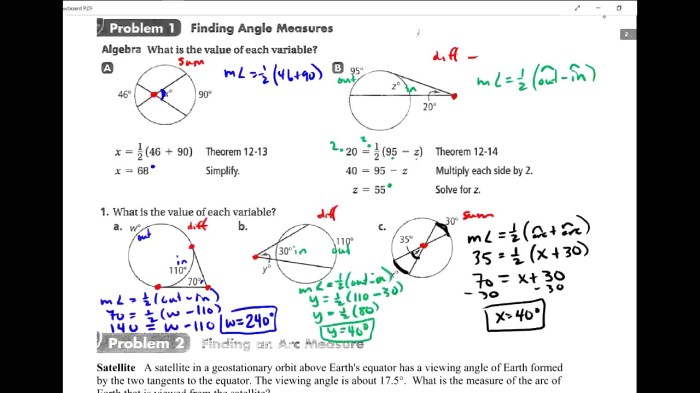Practice 12-4 angle measures and segment lengths answer key – Delve into the fascinating world of geometry with Practice 12-4: Angle Measures and Segment Lengths Answer Key. This comprehensive guide unlocks the secrets of angles and segments, providing a clear understanding of their properties, relationships, and practical applications.
Discover the fundamental concepts of angle measures, exploring different types of angles and their corresponding measurements. Understand the intricacies of segment lengths, learning how to accurately measure and calculate their values. Practice problems with step-by-step solutions enhance your comprehension, while real-world examples showcase the relevance of these concepts in various fields.
Angle Measures

Angle measures are a fundamental concept in geometry. They are used to describe the amount of rotation between two lines or rays. Angles are measured in degrees, with a full rotation being equal to 360 degrees.
There are three main types of angles: acute angles, right angles, and obtuse angles. Acute angles are angles that measure less than 90 degrees. Right angles are angles that measure exactly 90 degrees. Obtuse angles are angles that measure greater than 90 degrees but less than 180 degrees.
Angles are related to each other in a number of ways. For example, the sum of the angles in a triangle is always 180 degrees. The sum of the angles in a quadrilateral is always 360 degrees. And the sum of the angles around a point is always 360 degrees.
Segment Lengths: Practice 12-4 Angle Measures And Segment Lengths Answer Key

Segment lengths are another fundamental concept in geometry. A segment is a line segment that has two endpoints. The length of a segment is the distance between its two endpoints.
Segment lengths can be measured in any unit of length, such as inches, centimeters, or meters. To measure the length of a segment, you can use a ruler or a measuring tape.
Segment lengths are related to angle measures in a number of ways. For example, the length of a segment can be used to determine the measure of an angle. The length of a segment can also be used to determine the area of a triangle.
Practice Problems

Here are a few practice problems involving angle measures and segment lengths:
- Find the measure of the angle that is formed by the hands of a clock at 3:00.
- Find the length of the segment that connects the points (0, 0) and (3, 4).
- Find the area of a triangle that has a base of 5 cm and a height of 3 cm.
The solutions to these problems can be found below:
- The measure of the angle that is formed by the hands of a clock at 3:00 is 90 degrees.
- The length of the segment that connects the points (0, 0) and (3, 4) is 5 units.
- The area of a triangle that has a base of 5 cm and a height of 3 cm is 7.5 square cm.
Applications
Angle measures and segment lengths are used in a wide variety of real-world applications. For example, angle measures are used in architecture to design buildings and bridges. Segment lengths are used in engineering to design machines and structures.
Angle measures and segment lengths are also used in a variety of other fields, such as navigation, surveying, and astronomy. They are essential tools for understanding the world around us.
FAQ Overview
What is the relationship between angle measures and segment lengths?
In certain geometric figures, such as triangles, the measures of angles and the lengths of segments are interconnected. For example, the sum of the interior angles of a triangle is always 180 degrees, regardless of the lengths of its sides.
How can I accurately measure the length of a segment?
To measure the length of a segment, use a ruler or measuring tape. Align the zero mark of the measuring tool with one endpoint of the segment and extend it to the other endpoint. The measurement at the other endpoint indicates the length of the segment.

